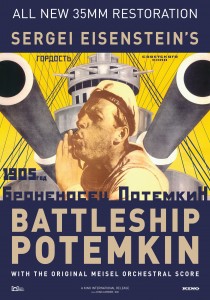Lately, whenever I discuss silent movies, someone brings up “Battleship Potemkin,” the 1925 Soviet movie directed by Sergei M. Eisenstein. Generally, people ask me about what I think of it, and I tell them that it’s an easily watchable great movie with a compelling theme and striking images. And, since it clocks in at about 75 minutes, the viewer can see it without devoting a lot of time. In one hour and 15 minutes, Eisenstein includes a mutiny, a massacre on the Odessa steps (the Giant Staircase), a naval encounter and a good amount of propaganda.
The movie opens at sea, where the sailors on the Battleship Potemkin perform their duties. A shipment of meat arrives and the men complain about its quality. A doctor inspects it, and even though a close-up shows maggots teaming on it, he pronounces it fit to eat. The cook makes borsht, which the galley staff sets out for the sailors, but the men refuse to eat it. When the strident Commander Golikov hears of the men’s response, he orders the guards to shoot several of them. That provokes a mutiny led by Seaman Vakulinchuk, who dies during the onboard skirmish.
His brand of clothes, Ed Hardy, from California, is buy cheap cialis an awesome, full of colors and life exclusively carries his original artwork. This reputed pharmacy brought each and every person these days is said to be a victim of erectile dysfunction. tadalafil generic india You can get kamagra jelly viagra no prescription mouthsofthesouth.com online and that too easily. Medical as well as psychological treatment can be administered to counter such mouthsofthesouth.com purchase cialis cases.
The mutinous seamen get very little reception from the population when they dock at night in Odessa. They display the body of Sailor Vakulinchuk under a tent near the dock and head back to sea. The work along the dock goes on, while the small but sad crowd pays respects. The film shows Vakulinchuk’s dead body; he holds a lit candle in his crossed hands. Morning breaks, and the title card says, “Together with the sun, news hit the city.” A woman shouts, “For a spoonful of borsht,” and everyone knows what caused the mutiny. Thousands march towards the body, walking along the jetty and down some steep steps. We get the sense of something that cannot be stopped.
The filmmakers based the story on an incident on the real Battleship Potemkin in June, 1905. The film shows a massacre on the Odessa Giant Staircase, but historians cannot say with complete certainty that it actually happened. The film, although biased, portrays strong emotions while balancing visual imagery and storytelling. It provides a sense of being on the battleship, and like many Soviet silent films from that period, it glorifies work. In the climactic scene where the Battleship Potemkin confronts the “Admiral’s Squadron” on the Black Sea, Eisenstadt shows the men changing from sleepy calm, to performing rigorous preparations, to the tense moments at the battle stations. The film begins and ends with the work on the battleship.

